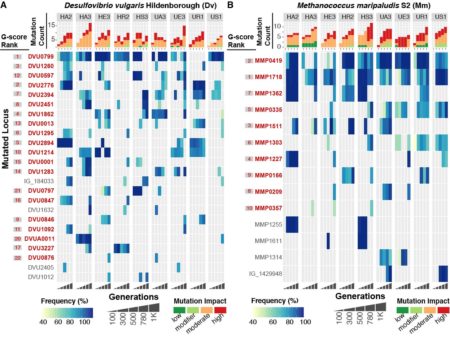Researchers map early adaptive events in evolution of mutualistic interactions with a broad range of applications for biotechnology, medicine and environment.
Turkarslan, Serdar; N. Stopnisek, A.W Thompson, C.E Arens, J.J Valenzuela, J. Wilson, K.A Hunt, J. Hardwicke, S. Lim, Y.M Seah, Y. Fu, L. Wu, J-Z Zhou, K.L Hillesland, D.A Stahl, N.S Baliga (2021) Synergistic epistasis enhances cooperativity of mutualistic interspecies interactions. ISME Journal [doi]: 1038/s41396-021-00919-9 OSTI ID: 1773759

The Science
Organisms from different species often interact in ways that benefit both organisms – a common ecological interaction called mutualism. Researchers have found evidence for how cooperativity in one example of mutualism, syntrophy, is established across evolutionary timescales. They have uncovered striking evidence that mutations accumulated during the evolution of syntrophy generate synergistic epistasis, or positive genetic interactions among rare individuals of a microbial community. These genetic interactions increase cooperativity within these rare microbial assemblages enabling their persistence at very low frequency within a larger productive population.
The Impact
This discovery should be of great interest to the diverse audience, because it explains how diverse microbial populations co-exist in dynamically changing environments, such as in reactors, lake sediments and the human gut. Moreover, the study incorporates multiscale systems analysis of diverse kinds of longitudinal datasets and experimental testing of hypotheses to characterize a complex phenomenon that emerges from interactions at the genetic level between two members of a microbial community. The methodologies, insights and resources generated by this study will have wide applicability to the study of other interspecies interactions and evolutionary phenomena.
Summary
This study builds on the prior work on mutualistic interactions among two microbes (Desulfovibrio vulgaris (Dv) and Methanococcus maripaludis (Mm)) that co-exist in diverse environments (gut, soil, etc.) and play a central role in an important step in biogeochemical C-cycling. It cuts across systems biology, microbiology, evolutionary biology and other disciplines. Researchers analyzed the temporal and combinatorial patterns in which mutations accumulated in both organisms over 1000 generations, mapped lineages through single cell sequencing of simplified sub-communities from the same evolved populations, and characterized growth rate, yield and cooperativity of pairings of their individual isolates. Through these analyses, researchers demonstrate for the first time that genetic interactions across rare genetic constituents of interacting species manifests in improved cooperativity enabling two sub-communities to co-exist in vastly different proportions. In addition, they discovered one of the first examples of parallel evolution, i.e accumulation of mutations in similar genes across independently evolving populations, underlying the evolution of both organisms in a mutualistic community.
ISB Researchers Discover How Microorganisms Evolve Cooperative Behaviors
Contact
Nitin S Baliga
Institute for Systems Biology, Seattle, WA 98133
Nitin.Baliga@isbscience.org
Serdar Turkarslan
Institute for Systems Biology, Seattle, WA 98133
Serdar.Turkarslan@isbscience.org

